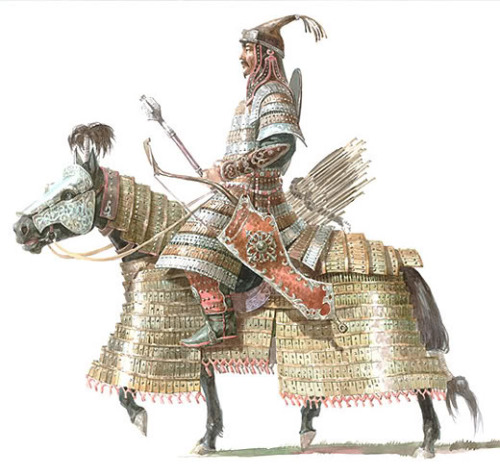peashooter85:The Forgotten Mongol Heavy Cavalry,When it comes to legends of the vicious Mongol conqu
peashooter85:The Forgotten Mongol Heavy Cavalry,When it comes to legends of the vicious Mongol conquests horse archers seem to be the celebrity rock stars of the Mongol Army who get all the fame and admiration. Depictions of Mongol battles in modern times usually show wild barbarian Mongol horse archers riding circles around enemy formations while showering them with volley after volley of arrows. Missing are the less glorified Mongol heavy cavalry, an absence which I’m sure would make the Great Khan sad because the Mongols had fine heavy cavalry. Not to put down horse archers, but horse archers alone don’t always win battles. While horse archers have their advantages, they also have several weakness and limitations, especially against opposing heavy infantry and cavalry equipped with shields and armor while in a battle formation. What made the Mongols effective was not the mere fact they had horse archers, but because they had better tactics, among them combined arms tactics where they were able to coordinate the abilities of different units to accomplish a goal on the battlefield. This isn’t just a principle of Mongol warfare, but a principle of warfare in general. Whether were talking ancient times or modern warfare, the side that has better combined arms tactics typically wins. The early Mongol Army consisted of 60% horse archers and 40% heavy cavalry. Later the Mongols would adopt new units such as heavy infantry, light infantry, and artillery conscripted from the peoples they conquered. However for this post I’m only referring to the early Mongol Army commanded by Genghis Khan and his general Subutai. The purpose of the horse archers were as skirmishing units; to harass, sow panic, and weaken the discipline of enemy ranks. The purpose of the heavy cavalry was to directly engage enemy units in close combat. To do their job, Mongol heavy cavalry were heavily armed and armored, much more so than their horse archer counterparts. They were armored head to toe in lamellar armor composed of metal plates sewn together into a suit. Often this armor also covered the horse as well. Their primary arm was a lance used to conduct charges. For melee fighting they would carry swords, and also maces for armored opponents. They would also probably carry a shield. Along with their horse archer counterparts, Mongol heavy cavalry also carried a bow in order to engage the enemey at a distance. In essence Mongol heavy cavalry were similar to Middle Eastern or Byzantine cataphracts and European mounted knights. On the battlefield, Mongol units typically fought in five ranks, the first three ranks composed of horse archers, the last two composed of heavy cavalry. During a Mongol charge, the horse archers would close to around 50 - 100 yards and fire arrows while the heavy cavalry would protect them from counterattack by enemy cavalry. It should be noted that Mongol heavy cavalry were also armed with bows, so likewise would be firing on the enemy as well. After firing, the formation would turn around, resupply with arrows, and remount with fresh horses. They would then repeat the charge again and again until eventually the enemy would weaken, begin to panic, lose discipline, and perhaps break ranks. At that point the heavy cavalry would swoop in and smash the enemy formation. The Mongols also used deceptive tactics which the heavy cavalry would be an essential part. One common tactic was the feigned retreat, where a Mongol unit would pretend to retreat in panic as if defeated. The enemy would in turn charge expecting to chase down and massacre a terrified enemy. To their horror, the Mongols would reform and counterattack, the heavy cavalry at the front to smash the disorganized enemy like Cheerios with a sledgehammer and the horse archers firing from the rear. Another tactic would be to use the horse archers to draw the enemy into an ambush, where the heavy cavalry would appear from a hidden position and conduct a surprise attack on the enemy flanks or rear. -- source link

